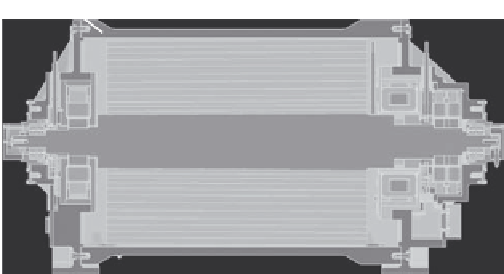Environmental Engineering Reference
In-Depth Information
Flywheel
housing
Composite flywheel
Balance holes
Damper
and
backup
bearing
Magnetic bearing
sensors
Radial magnetic
bearing
Rotor axial
position
sensor
Magnetic
bearing
sensors
Combo
magnetic
bearing
End plate mount
Phase angle
sensors
Composite banding for
motor/generator section
Motor/generator
rotor magnets,
back iron
Titanium
rotor
shaft
End plate/mount
Figure 10.42 Flywheel energy storage system (from Reference 30)
withstanding the hoop stress resulting from centrifugal forces are - as is the case
with electrochemical batteries - the lightest materials available having the highest
tensile stress. This is because the hoop stress grows in proportion to the density of
the material used, whereas stored energy grows as the square of angular speed. A
lightweight material flywheel will store the same energy as a steel flywheel but
weigh less. The amount of energy stored in a flywheel is equal to one-half the
tensile stress at the bursting point of the rim material divided by its density.
Mathematically this is expressed as
K
mx
2
r
E
FW
¼
(Wh
=
kg)
ð
10
:
66
Þ
where
K
mx
is the limiting tensile stress at which point the rim will delaminate or
burst. Fibres that offer the highest energy storage density are derived from E-glass,
which can store four times as much energy as high strength steel. Kevlar, an aro-
matic polyamide, derived from nylon can store seven times the energy of high
strength steel. Probably the best choice of fibre is fused silica glass, which can store
up to 15 times the energy of the best alloy steel. A flywheel energy storage unit
will be far lighter than an electrochemical battery. Estimates of energy storage
for electric vehicles centre on 30 kWh to provide a 200 mi range at reasonable
speeds (55 mph in North America). A lead-acid battery rated 30 kWh would weigh
1,000 kg, and a fused silica flywheel would come in at 60 kg plus the electric drive
system to charge/discharge the unit. If the power electronics and drive motor could
tolerate the power level, this 30 kWh flywheel could be recharged in 5 min.
The real advantage of flywheel energy storage is the high rate of energy input
and release possible. This is particularly advantageous on regenerative braking.
Flywheel energy storage is now being used extensively in electric rail applications
as energy storage stations near stops in lieu of adding more utility substations. The
































































































































